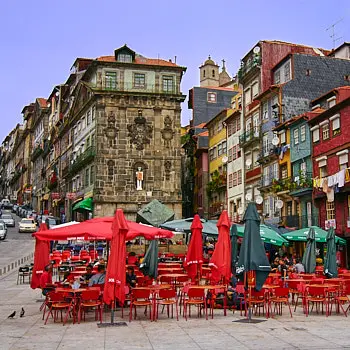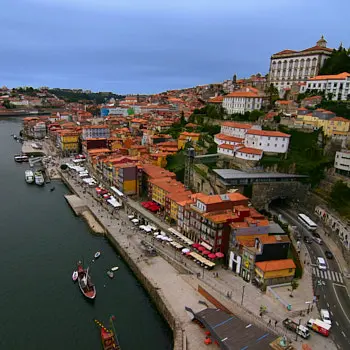Are you planning a trip to Porto? This comprehensive guide will take you through the must-see sights and attractions of this enchanting city. You can treat this guide as 2-day itinerary. From historic landmarks to stunning views, discover the beauty of Porto and make the most of your visit.

Visit the Historic Ribeira District
One of the must-see sights in Porto is the historic Ribeira District. This charming neighborhood is located along the banks of the Douro River and is known for its colorful buildings, narrow streets, and lively atmosphere. Ribeira has been a designated UNESCO World Heritage site since 1996. Its historical significance lies in its well-preserved medieval streets, architecture, and its role as a commercial and cultural hub. Take a stroll along the waterfront promenade and admire the picturesque views of the river and the iconic Dom Luís I Bridge. Explore the winding streets and discover hidden gems such as traditional taverns, local shops, and charming cafes. Don't forget to visit the Ribeira Square, a bustling plaza surrounded by historic buildings and filled with outdoor cafes and street performers. The Ribeira District is a true gem of Porto and should not be missed during your visit.
Explore the Majestic Porto Cathedral
The Porto Cathedral, known as Sé do Porto or simply Porto Cathedral, is one of the city's most important religious and architectural landmarks. The Porto Cathedral is one of the oldest and most significant religious buildings in Porto. Its construction began in the 12th century and continued over several centuries, resulting in a mix of architectural styles, including Romanesque, Gothic, and Baroque. The original structure of the cathedral reflects the Romanesque architectural style, characterized by thick walls, rounded arches, and simple, sturdy designs. The main façade, with its fortress-like appearance, is an excellent example of Romanesque architecture. Over the years, the cathedral underwent several modifications and additions. During the 13th and 14th centuries, Gothic elements were incorporated into the building, including pointed arches, ribbed vaults, and ornate decorations. The stunning rose window on the western façade is a notable Gothic feature.
The interior of the Porto Cathedral features a nave and side aisles, with a series of chapels along the sides. Inside, visitors can admire intricate woodwork, ornate altars, beautiful stained glass windows, and religious artifacts. The cathedral's main chapel houses the silver altarpiece, a stunning Baroque masterpiece.
One of the highlights of visiting the Porto Cathedral is the opportunity to ascend to its rooftop terrace. From there, you can enjoy panoramic views of the city, including the historic Ribeira district, the Douro River, and the nearby neighborhoods. It's a great vantage point for capturing memorable photographs.
The cathedral is still an active place of worship and an important religious site in Porto. It serves as the seat of the Bishop of Porto and is a significant pilgrimage destination.

Take a Stroll Across the Iconic Dom Luís I Bridge
Cross the Dom Luís I Bridge to Vila Nova de Gaia. Here, you can visit the famous Port wine cellars and enjoy a guided tour and tasting at one of the renowned wineries such as Sandeman, Taylor's, or Graham's.
The Dom Luís I Bridge, also known as Ponte Dom Luís I, is one of the most iconic landmarks in Porto and a must-see sight for visitors. This double-deck iron bridge spans the Douro River, connecting the city center with the Vila Nova de Gaia district. It was designed by the Belgian engineer Théophile Seyrig, who worked with Gustave Eiffel, the renowned architect behind the Eiffel Tower. The bridge consists of two levels. The upper level, which is 395 meters (1,296 feet) long, carries road traffic, while the lower level, 174 meters (571 feet) long, accommodates the Porto Metro's D Line and pedestrians. The bridge's most distinctive feature is its elegant arched design. The arches give the bridge a sense of grandeur and allow for the passage of larger ships beneath it. The lower level of the bridge is supported by a series of massive granite pillars.
As you walk across the bridge, you'll be treated to breathtaking views of the river, the historic Ribeira district, and the colorful houses that line the waterfront. It is especially striking during sunrise, sunset, and nighttime when the city lights illuminate the landscape. If you're feeling adventurous, you can even take a ride on the upper deck of the bridge, where you'll have an even more panoramic view of the city.
Enjoy a Port Wine Tasting in the Cellars of Vila Nova de Gaia
No visit to Porto is complete without indulging in a port wine tasting experience in the cellars of Vila Nova de Gaia. Located just across the Douro River from Porto, Vila Nova de Gaia is home to numerous port wine cellars where you can learn about the history and production of this famous Portuguese wine. Take a guided tour of one of the cellars, where you'll have the opportunity to see the barrels where the wine is aged and learn about the different varieties and flavors. After the tour, sit back and relax as you sample a selection of port wines, from the sweet and fruity to the rich and complex. It's a truly immersive experience that will leave you with a newfound appreciation for this iconic drink.
Marvel at the Intricate Tiles of São Bento Train Station
São Bento Train Station is not only a transportation hub but also a stunning architectural gem in Porto. The station was named after the Benedictine monastery that previously occupied the site. The station building is known for its exquisite Beaux-Arts architectural style. It was designed by José Marques da Silva, a prominent Portuguese architect, and construction began in the late 19th century, with the station opening to the public in 1916. The station's most striking feature is its interior walls adorned with traditional Portuguese azulejo tiles. The blue and white tiles depict scenes from Portuguese history, rural life, and transportation, creating a stunning visual display that attracts both locals and visitors. As you step inside the station, you'll be greeted by a breathtaking display of these hand-painted tiles, covering the walls and telling stories of the past. The azulejo tile panels at São Bento Train Station were created by the renowned Portuguese artist Jorge Colaço. The scenes depicted on the tiles include significant historical events such as battles, royal processions, and everyday life in the region. Take your time to admire the craftsmanship and attention to detail that went into creating these beautiful works of art.
Visit the Clérigos Tower
At the end of your short trip to Porto visit the Clérigos Tower, an iconic symbol of Porto, and climb to the top for panoramic views of the city.
The Clérigos Tower is a tall bell tower that is part of the Clérigos Church (Igreja dos Clérigos). It was designed by Nicolau Nasoni, an Italian architect, and was built between 1754 and 1763. The tower stands at a height of 75.6 meters (248 feet) and offers panoramic views of the city. The tower's architectural style is predominantly Baroque, with some elements of Rococo. The exterior features intricate details, ornate decorations, and a robust structure. The tower's design is a testament to the skill and creativity of Nasoni. The tower houses a set of 49 bells, which were cast in Antwerp, Belgium. The bells used to ring to signal important events and mark the passing of time. Today, they continue to chime, creating a melodic ambiance that can be heard throughout the area.
